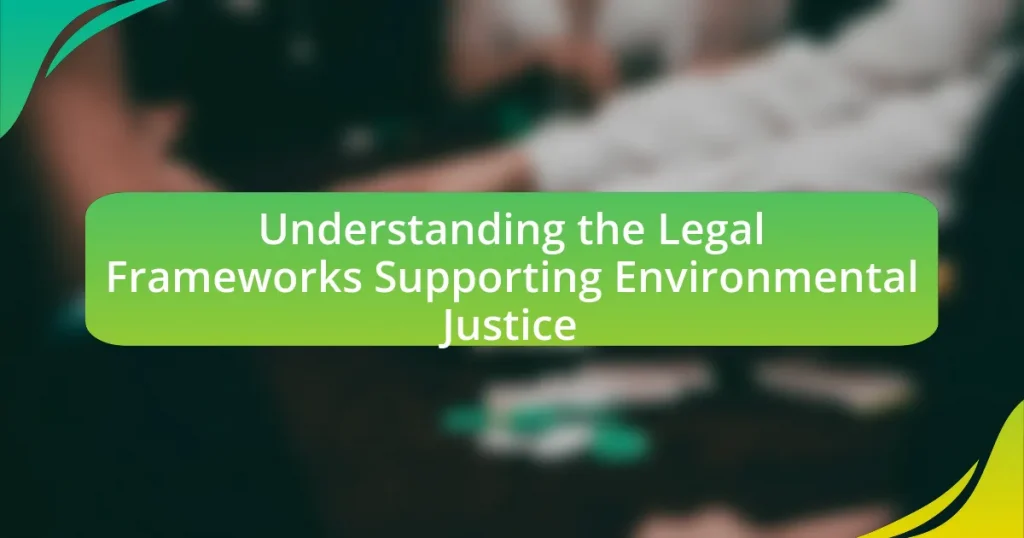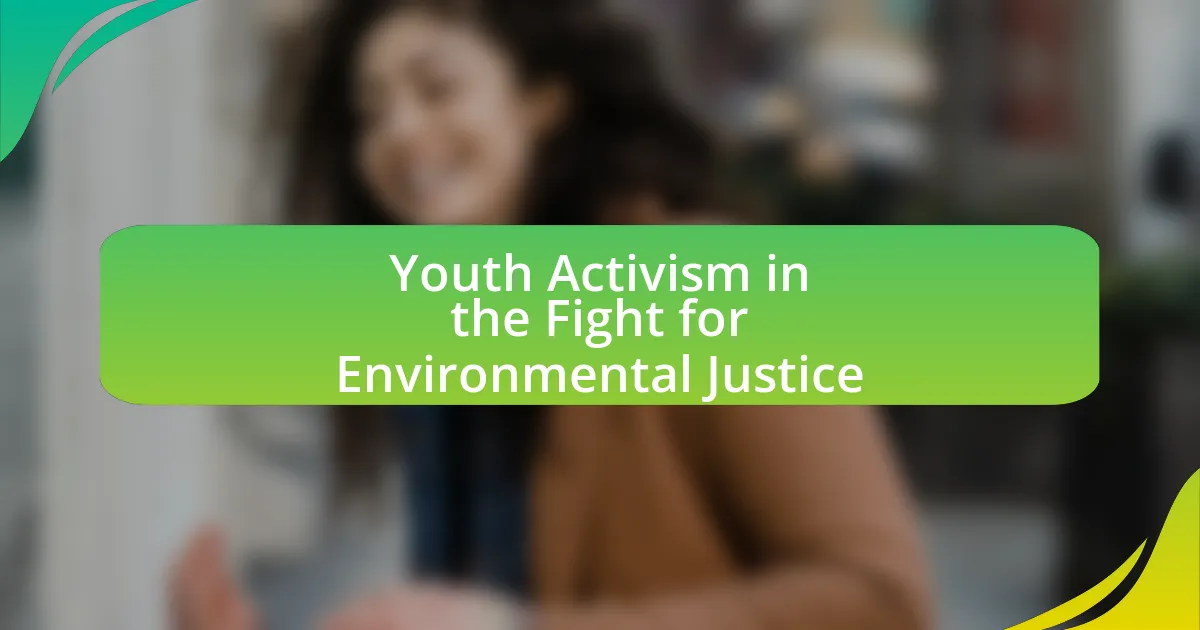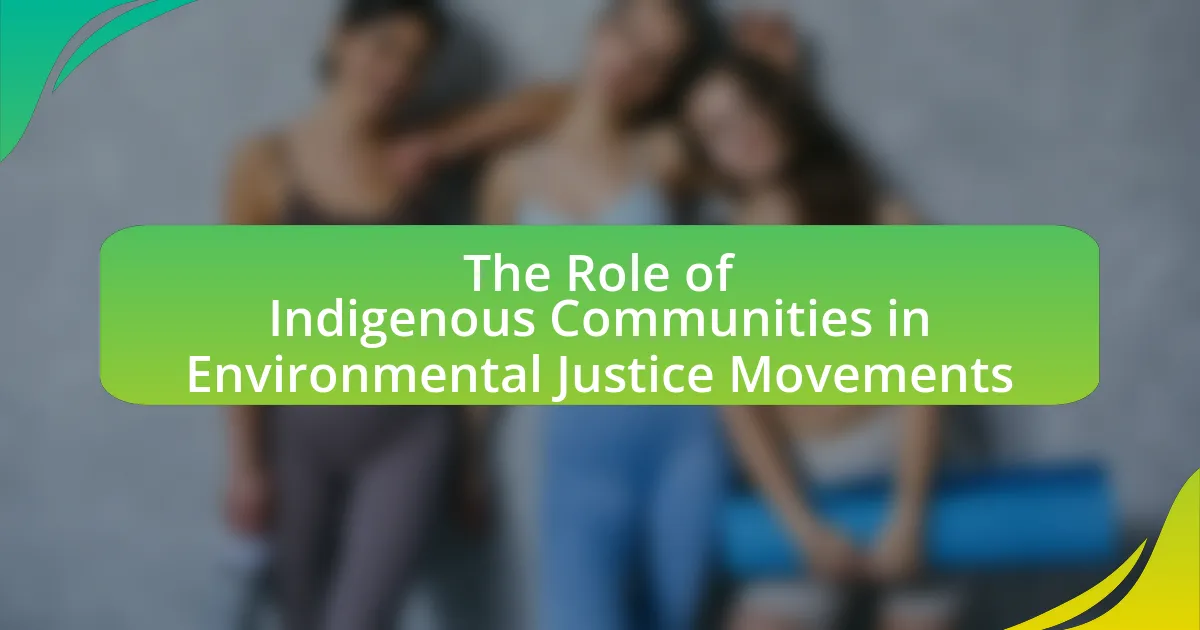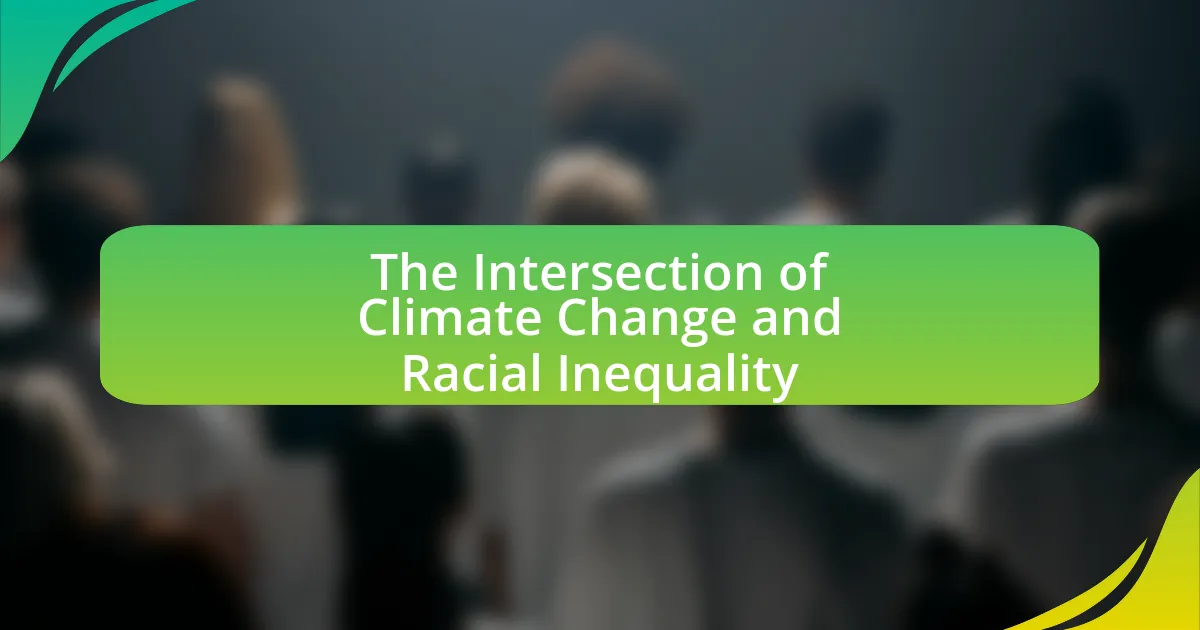The article focuses on the legal frameworks supporting environmental justice, which aim to address the disproportionate environmental burdens faced by marginalized communities. It outlines key legislation such as the National Environmental Policy Act (NEPA) and Title VI of the Civil Rights Act, which mandate environmental assessments and prohibit discrimination in federally funded programs. The article also discusses the principles of environmental justice, the role of federal and state laws, and the enforcement mechanisms that protect vulnerable populations from environmental harm. Additionally, it highlights the importance of community engagement and grassroots movements in influencing legal outcomes and advocating for equitable environmental policies.

What is the Legal Framework Supporting Environmental Justice?
The legal framework supporting environmental justice primarily consists of federal and state laws that aim to address the disproportionate environmental burdens faced by marginalized communities. Key legislation includes the National Environmental Policy Act (NEPA), which mandates environmental assessments for federal projects, and Title VI of the Civil Rights Act, which prohibits discrimination based on race, color, or national origin in programs receiving federal assistance. Additionally, the Environmental Protection Agency (EPA) has established policies and initiatives specifically targeting environmental justice, such as the Environmental Justice Strategy and the Justice40 Initiative, which aims to direct 40% of federal investments in climate and clean energy to disadvantaged communities. These laws and policies collectively work to ensure equitable treatment and meaningful involvement of all people in environmental decision-making processes.
How does the legal framework define environmental justice?
The legal framework defines environmental justice as the fair treatment and meaningful involvement of all people, regardless of race, color, national origin, or income, in environmental laws, regulations, and policies. This definition is rooted in the U.S. Environmental Protection Agency’s (EPA) commitment to ensuring that no group of people, particularly marginalized communities, bears a disproportionate share of negative environmental consequences. The legal framework aims to address historical injustices and promote equitable access to environmental benefits, as established in Executive Order 12898, which mandates federal agencies to consider environmental justice in their decision-making processes.
What are the key principles of environmental justice in legal terms?
The key principles of environmental justice in legal terms include the equitable distribution of environmental benefits and burdens, the right to participate in decision-making processes, and the protection of vulnerable communities from environmental harm. These principles are grounded in the recognition that marginalized groups often face disproportionate exposure to environmental hazards and lack adequate representation in environmental governance. Legal frameworks, such as the National Environmental Policy Act (NEPA) and Title VI of the Civil Rights Act, support these principles by mandating environmental assessments and prohibiting discrimination in federally funded programs. These laws aim to ensure that all communities, regardless of race or socioeconomic status, have a voice in environmental matters and access to a healthy environment.
How do these principles influence policy-making?
Principles of environmental justice influence policy-making by ensuring that marginalized communities receive equitable treatment and protection from environmental hazards. These principles guide lawmakers to incorporate community input, assess environmental impacts, and prioritize the needs of vulnerable populations in policy development. For instance, the National Environmental Policy Act mandates federal agencies to consider environmental justice in their decision-making processes, which has led to more inclusive policies that address the disproportionate effects of pollution on low-income and minority communities. This alignment of policy with environmental justice principles fosters accountability and promotes sustainable practices that benefit all societal segments.
Why is a legal framework necessary for environmental justice?
A legal framework is necessary for environmental justice because it establishes enforceable rights and obligations that protect marginalized communities from environmental harm. This framework ensures accountability for polluters and provides mechanisms for affected individuals to seek redress. For instance, the Civil Rights Act of 1964 has been used to challenge discriminatory environmental practices, demonstrating how legal tools can address inequities. Additionally, the National Environmental Policy Act (NEPA) mandates environmental assessments, which help identify and mitigate adverse impacts on vulnerable populations. These legal structures are essential for promoting equitable treatment and safeguarding the health and well-being of all communities.
What historical events led to the establishment of these legal frameworks?
The establishment of legal frameworks supporting environmental justice was significantly influenced by the civil rights movement of the 1960s, which highlighted systemic inequalities faced by marginalized communities. Key events include the 1969 Santa Barbara oil spill, which raised public awareness about environmental hazards, and the 1982 protests against a hazardous waste landfill in Warren County, North Carolina, which galvanized grassroots activism and led to the recognition of environmental racism. These events prompted the U.S. government to address environmental justice, culminating in the 1994 Executive Order 12898, which directed federal agencies to consider environmental justice in their policies.
How do legal frameworks address systemic inequalities?
Legal frameworks address systemic inequalities by establishing laws and regulations that promote equal rights and opportunities for marginalized groups. These frameworks often include anti-discrimination laws, affirmative action policies, and environmental justice statutes that aim to rectify historical injustices and ensure equitable access to resources and decision-making processes. For instance, the Civil Rights Act of 1964 prohibits discrimination based on race, color, religion, sex, or national origin, thereby addressing systemic inequalities in various sectors, including employment and education. Additionally, the Environmental Protection Agency’s Title VI of the Civil Rights Act ensures that no person is subjected to discrimination under any program receiving federal assistance, directly linking environmental justice to the fight against systemic inequalities.
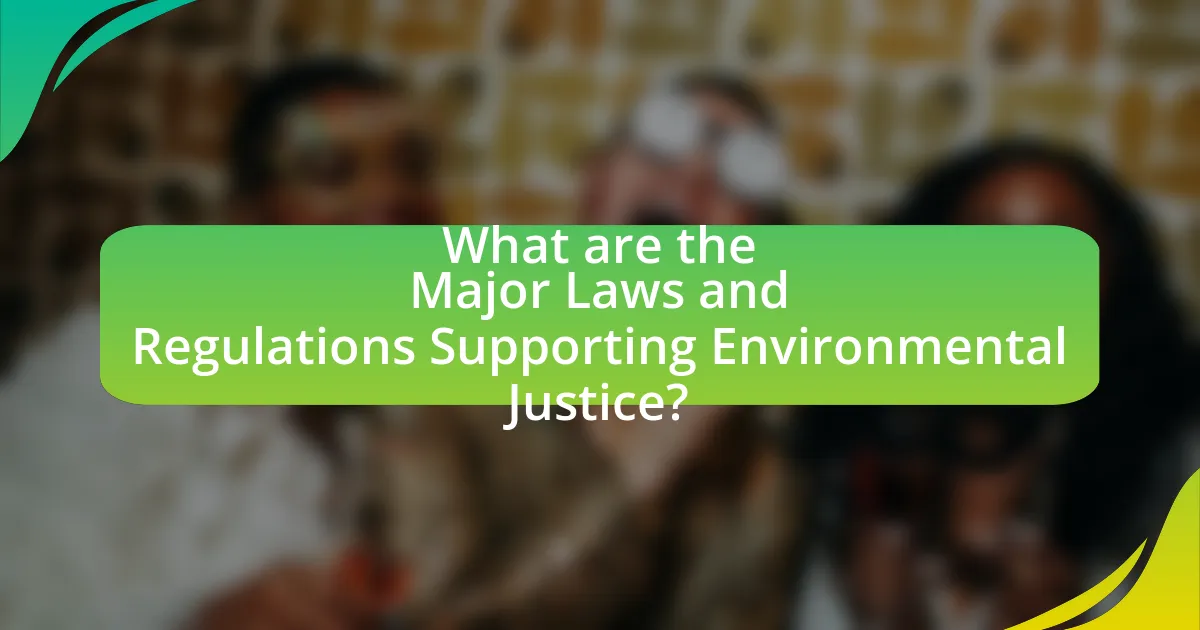
What are the Major Laws and Regulations Supporting Environmental Justice?
The major laws and regulations supporting environmental justice include the National Environmental Policy Act (NEPA), Title VI of the Civil Rights Act of 1964, the Clean Air Act, and the Clean Water Act. NEPA requires federal agencies to assess the environmental effects of their proposed actions before making decisions, ensuring that marginalized communities are considered. Title VI prohibits discrimination based on race, color, or national origin in programs receiving federal assistance, which has been used to address environmental disparities. The Clean Air Act and Clean Water Act establish standards to protect air and water quality, directly benefiting communities disproportionately affected by pollution. These laws collectively aim to ensure equitable treatment and protection for all communities, particularly those historically marginalized.
Which federal laws are pivotal in promoting environmental justice?
The pivotal federal laws promoting environmental justice include the National Environmental Policy Act (NEPA), the Clean Air Act, and the Clean Water Act. NEPA, enacted in 1969, requires federal agencies to assess the environmental impacts of their proposed actions, ensuring that marginalized communities are considered in decision-making processes. The Clean Air Act, established in 1970, aims to control air pollution and protect public health, particularly benefiting vulnerable populations disproportionately affected by poor air quality. The Clean Water Act, passed in 1972, regulates discharges of pollutants into U.S. waters, safeguarding the health of communities reliant on these water sources. Collectively, these laws form a framework that addresses environmental disparities and promotes equitable treatment of all communities.
What role does the National Environmental Policy Act play?
The National Environmental Policy Act (NEPA) plays a crucial role in ensuring that federal agencies consider the environmental impacts of their proposed actions before making decisions. NEPA requires federal agencies to prepare detailed environmental impact statements (EIS) for major projects that significantly affect the environment, thereby promoting informed decision-making and public participation. This process helps to identify potential adverse environmental effects and explore alternatives, ultimately fostering transparency and accountability in government actions related to environmental justice.
How does the Clean Air Act contribute to environmental justice?
The Clean Air Act contributes to environmental justice by establishing regulations that reduce air pollution, particularly in low-income and minority communities disproportionately affected by poor air quality. This legislation mandates the Environmental Protection Agency to set and enforce air quality standards, which aim to protect vulnerable populations from harmful pollutants. For instance, studies have shown that areas with high levels of industrial activity often coincide with communities of color, leading to increased health risks. By prioritizing the reduction of emissions and ensuring compliance through monitoring and enforcement, the Clean Air Act helps mitigate these disparities, promoting equitable health outcomes across different demographics.
What state-level regulations exist to support environmental justice?
State-level regulations that support environmental justice include laws that mandate public participation in environmental decision-making, such as California’s Environmental Justice Law, which requires state agencies to consider the impacts of their actions on disadvantaged communities. Additionally, New Jersey’s Environmental Justice Law mandates that certain facilities undergo an environmental justice impact statement before receiving permits, ensuring that the potential effects on vulnerable populations are assessed. These regulations aim to address and mitigate the disproportionate environmental burdens faced by marginalized communities, thereby promoting equitable treatment and involvement in environmental governance.
How do state laws vary in their approach to environmental justice?
State laws vary significantly in their approach to environmental justice, with some states implementing comprehensive frameworks while others lack specific legislation. For instance, California has established the Office of Environmental Justice and mandates that state agencies consider environmental justice in their decision-making processes, reflecting a proactive stance. In contrast, states like Texas have fewer formal mechanisms, relying more on federal guidelines and community advocacy without specific state-level mandates. This disparity illustrates how state priorities and political climates influence the effectiveness and scope of environmental justice initiatives, leading to varied protections and resources for affected communities across the United States.
What are some successful state-level initiatives?
Successful state-level initiatives include California’s Cap-and-Trade Program, which has reduced greenhouse gas emissions by over 25% since its inception in 2013, and New York’s Environmental Justice Policy, which mandates that state agencies consider environmental justice in their decision-making processes. These initiatives demonstrate effective frameworks for addressing environmental issues and promoting equity, as evidenced by California’s achievement of a 40% reduction in emissions by 2030 and New York’s establishment of community engagement processes that empower marginalized populations.
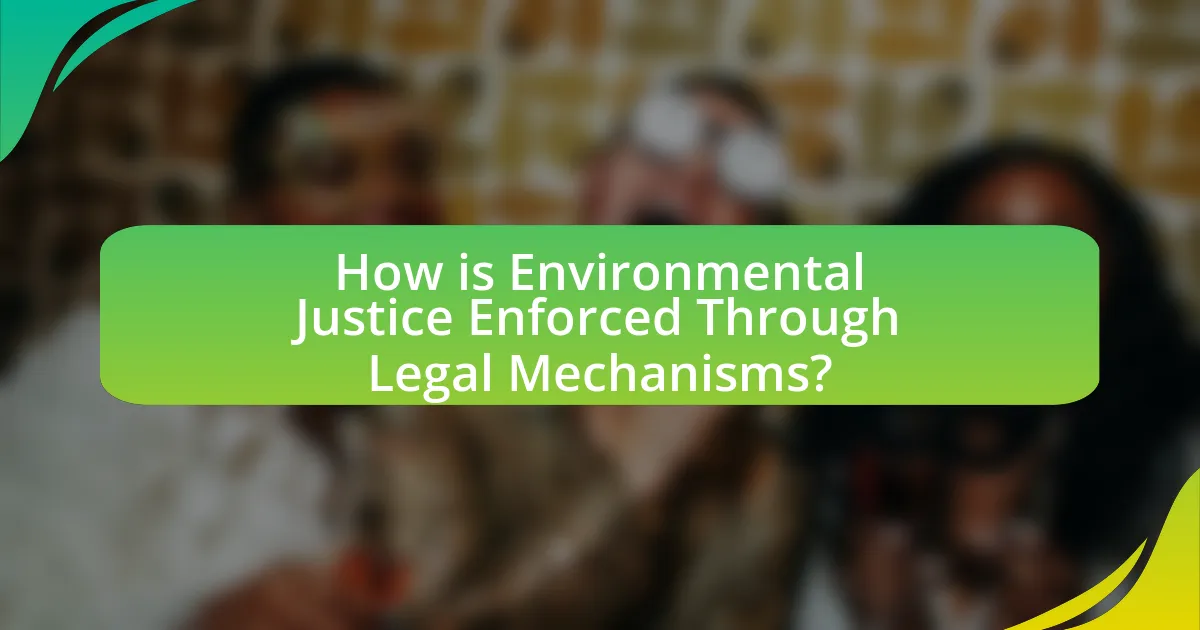
How is Environmental Justice Enforced Through Legal Mechanisms?
Environmental justice is enforced through legal mechanisms primarily via statutes, regulations, and judicial actions that aim to protect marginalized communities from environmental harm. Key legal frameworks include the National Environmental Policy Act (NEPA), which mandates environmental assessments for federal projects, and the Clean Air Act, which sets air quality standards to protect public health. Additionally, civil rights laws, such as Title VI of the Civil Rights Act, prohibit discrimination in federally funded programs, thereby addressing environmental disparities. Courts have also played a role by adjudicating cases that challenge harmful practices affecting vulnerable populations, reinforcing the principle that all communities deserve equal protection under environmental laws.
What agencies are responsible for enforcing environmental justice laws?
The agencies responsible for enforcing environmental justice laws include the Environmental Protection Agency (EPA), the Department of Justice (DOJ), and various state environmental agencies. The EPA plays a central role by implementing regulations that address environmental disparities and ensuring compliance with environmental laws. The DOJ supports enforcement through legal actions against violations of environmental laws that disproportionately affect marginalized communities. Additionally, state agencies often have their own environmental justice initiatives and enforcement mechanisms tailored to local contexts. These agencies collectively work to uphold environmental justice principles and address inequities in environmental protection.
How do these agencies collaborate with communities?
Agencies collaborate with communities through partnerships that facilitate communication, resource sharing, and joint initiatives aimed at addressing environmental justice issues. These collaborations often involve community engagement processes, where agencies seek input from local residents to inform policy decisions and program development. For instance, the Environmental Protection Agency (EPA) has established programs like the Environmental Justice Collaborative Problem-Solving Model, which encourages communities to work alongside agency representatives to identify and resolve environmental challenges. This model has been effective in fostering trust and ensuring that community voices are heard in decision-making processes, thereby enhancing the overall effectiveness of environmental policies.
What are the challenges faced by enforcement agencies?
Enforcement agencies face several challenges, including limited resources, jurisdictional conflicts, and the complexity of environmental laws. Limited resources hinder their ability to conduct thorough investigations and enforce regulations effectively. Jurisdictional conflicts arise when multiple agencies have overlapping responsibilities, leading to inefficiencies and gaps in enforcement. Additionally, the complexity of environmental laws can create difficulties in interpretation and application, making it challenging for agencies to ensure compliance and prosecute violations. These challenges are compounded by the need for specialized training and expertise in environmental science and law, which many agencies may lack.
How can communities engage with the legal framework for environmental justice?
Communities can engage with the legal framework for environmental justice by actively participating in public comment periods, attending hearings, and collaborating with legal advocacy organizations. These actions allow communities to voice their concerns regarding environmental policies and practices that disproportionately affect marginalized populations. For instance, the Environmental Protection Agency (EPA) encourages public involvement in decision-making processes, which can lead to more equitable outcomes. Additionally, communities can utilize legal tools such as lawsuits to challenge unjust practices, as seen in cases like the landmark decision in Massachusetts v. EPA, where the court recognized the agency’s obligation to regulate greenhouse gases. Engaging in these ways empowers communities to influence environmental policies and hold entities accountable for environmental injustices.
What resources are available for communities seeking legal support?
Communities seeking legal support can access various resources, including legal aid organizations, pro bono services, and community law clinics. Legal aid organizations, such as the Legal Services Corporation, provide free legal assistance to low-income individuals and communities, ensuring access to justice. Pro bono services offered by law firms and individual attorneys allow communities to receive legal representation without cost, often focusing on civil rights and environmental justice cases. Community law clinics, often affiliated with law schools, offer legal advice and representation while also educating communities about their rights and legal options. These resources collectively empower communities to navigate legal challenges effectively, particularly in the context of environmental justice.
How can grassroots movements influence legal outcomes?
Grassroots movements can influence legal outcomes by mobilizing public support, raising awareness, and advocating for policy changes that align with their objectives. These movements often engage in campaigns that highlight social injustices, which can lead to increased public pressure on lawmakers and judicial systems. For example, the environmental justice movement has successfully pushed for legislation such as the National Environmental Policy Act, which requires federal agencies to assess environmental impacts, largely due to grassroots advocacy. Additionally, grassroots organizations often provide legal resources and support to affected communities, enabling them to challenge unjust practices in court, as seen in cases like the fight against the Dakota Access Pipeline, where local activists played a crucial role in legal challenges.
What are the best practices for advocating for environmental justice?
The best practices for advocating for environmental justice include building coalitions with affected communities, engaging in policy advocacy, and utilizing legal frameworks to address environmental disparities. Building coalitions allows advocates to amplify the voices of marginalized groups, ensuring their concerns are prioritized in decision-making processes. Engaging in policy advocacy involves lobbying for equitable environmental regulations and participating in public comment periods to influence legislation. Utilizing legal frameworks, such as the National Environmental Policy Act and Title VI of the Civil Rights Act, provides a basis for challenging discriminatory practices and holding entities accountable for environmental harm. These practices are supported by evidence showing that community-led initiatives and legal actions have successfully led to improved environmental conditions in historically marginalized areas.
